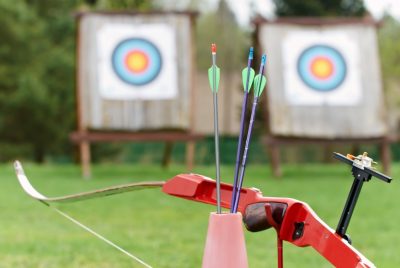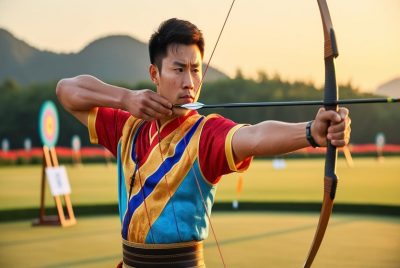Tracking progress is one of the most powerful tools an archer can have. While hours at…
10 Ways To Incorporate Physical Fitness Into Archery Training

Archery might seem like a sport that relies solely on precision and focus, but anyone who has spent hours at the range knows that physical fitness plays a massive role in performance.
Building strength, improving endurance, and enhancing stability can dramatically improve accuracy and consistency.
By embracing archery fitness training, we equip our bodies to handle longer sessions, maintain proper form, and prevent injuries that can derail progress.
Here, we’ll explore ten practical ways archers can seamlessly integrate fitness into their training routines.
1)) Strengthen Your Back and Shoulders
Your back and shoulders are the unsung heroes of archery. The drawing motion engages the rhomboids, trapezius, and deltoids continuously, so building strength in these areas translates directly into better performance.
How to Train:
- Rows: Dumbbell, cable, or resistance band rows mimic the pulling motion of drawing the bow.
- Pull-Ups: Improve upper body strength and endurance, particularly in the lats.
- Shoulder Presses: Build stability and prevent fatigue during long sessions.
Why it Matters: Think of your back and shoulders as the engine of your bow. A strong engine holds your draw smoothly and consistently, much like a car maintaining speed on a hill without sputtering.
2)) Develop Core Stability
A solid core is essential for maintaining posture and balance while aiming. Your abdominals, obliques, and lower back muscles act as stabilizers, keeping your torso steady.
How to Train:
- Planks: Front and side planks enhance overall core endurance.
- Russian Twists: Improve rotational strength that helps maintain alignment.
- Deadbugs: Promote controlled movement and prevent sway during the draw.
Pro Tip: Visualize your core as the tripod that supports your upper body. A wobbly tripod makes for shaky shots; a strong core keeps everything steady.
3)) Build Arm Strength and Grip Endurance
The forearms, biceps, and triceps are constantly working in archery. Grip strength is often underestimated but is crucial for releasing the string cleanly and consistently.
Exercises:
- Bicep Curls & Tricep Extensions: Increase draw power and control.
- Wrist Curls & Reverse Curls: Build forearm endurance.
- Farmer’s Carries: Enhance grip and overall arm stability.
Insight: Think of your arms like the strings of a well-tuned instrument—the stronger and more controlled they are, the more harmonious your shot.
4)) Incorporate Leg Strength and Balance
Although it may surprise some, your legs are foundational in archery. Strong legs and hips create a stable stance and reduce wobble during the draw.
Training Tips:
- Squats & Lunges: Build lower body strength for a firm stance.
- Single-Leg Exercises: Improve balance and stability.
- Balance Drills: Using a BOSU ball or wobble board can simulate real-life archery stance challenges.
Why it Works: Think of your legs as the roots of a tree. Deep, strong roots prevent the tree from tipping in the wind. Similarly, strong legs keep you steady in any shooting scenario.
5)) Improve Cardiovascular Endurance
Walking long distances between targets, holding your draw repeatedly, and maintaining focus for hours all require stamina. Cardiovascular fitness prevents fatigue and helps maintain consistency.
Cardio Options:
- Brisk walking or hiking
- Interval jogging or cycling
- Rowing for low-impact endurance
Tip: Try shooting after a short cardio session. This simulates tournament conditions when your body might be tired, training both fitness and mental focus.
6)) Emphasize Flexibility and Mobility
Archery demands a wide range of motion, particularly in the shoulders, thoracic spine, and hips. Poor flexibility can limit draw length and increase injury risk.
Exercises:
- Shoulder and chest stretches to open up the upper body.
- Thoracic rotations for spine mobility.
- Hip flexor and hamstring stretches for balanced posture.
Analogy: Imagine trying to pull a bow with a stiff rubber band—it won’t reach its full potential. Flexibility ensures your muscles can stretch and move freely, maximizing performance.
7)) Train Mental Focus and Breath Control
Physical fitness enhances mental resilience, but mental training itself is critical in archery. Controlling breath and maintaining calm under pressure directly affects shot accuracy.
Techniques:
- Controlled breathing exercises before and during shooting.
- Meditation or visualization to enhance focus.
- Practice shooting under slight fatigue to mimic competitive conditions.
Why it Matters: Calm, steady breathing acts like a stabilizer for your entire body. Just as a boat remains steady with a well-tied anchor, your shots remain consistent with controlled breath.
8)) Integrate Sport-Specific Exercises
Archery fitness training isn’t just about general strength—it’s about mimicking the movements you perform with your bow.
Examples:
- Isometric Holds: Hold the bow at full draw to build endurance in stabilizing muscles.
- Band Pull-Aparts: Strengthen scapular muscles for better control.
- Single-Arm Rows: Mirror the unilateral motion of drawing the bow.
Pro Insight: These exercises are like rehearsal shots for your muscles. They train the body exactly how it will perform during competition.
9)) Structure a Balanced Weekly Routine
Balancing archery practice with fitness prevents burnout and ensures steady progress. A well-structured routine keeps your body and mind fresh.
Suggested Schedule:
- Strength Training: 2–3 sessions per week focusing on upper body, core, and legs.
- Cardio: 2–3 moderate sessions for endurance.
- Flexibility & Mobility: Daily stretching or yoga sessions.
- Archery Practice: Combine technique work with physical conditioning for the best results.
Tip: Alternate heavy strength days with lighter cardio or practice-focused days to prevent fatigue from affecting your shots.
10)) Monitor Progress and Adjust Accordingly
Fitness for archery is not one-size-fits-all. Tracking improvements in strength, stability, and endurance ensures your training translates into better performance.
How to Track:
- Record reps, sets, or hold times for key exercises.
- Note any improvements in draw time or shot consistency.
- Adjust training intensity based on fatigue levels and progress.
Analogy: Think of this like sighting in your bow. You make small adjustments over time to hit the target consistently. Your fitness plan should be just as precise.
Pro Tip: Investing in a home gym system is one of the smartest ways to elevate your archery performance.
Strength training at home allows you to focus on key muscle groups—like your back, shoulders, and core—that are essential for steady aim and powerful draws.
With home workout equipment such as resistance bands, adjustable dumbbells, or a cable system, you can conveniently build strength, balance, and endurance without needing daily trips to the gym.
Having your own setup keeps you consistent, making it easier to integrate targeted workouts into your archery routine and see measurable improvements in accuracy and shot control over time.
Conclusion
Archery is a unique sport that combines precision, focus, and physical endurance.
Incorporating archery fitness training into your routine isn’t just about building muscle—it’s about creating a resilient, stable, and controlled body capable of performing at its best.
From strengthening your back and shoulders to enhancing core stability, improving flexibility, and building mental focus, each element contributes to more consistent and powerful shots.
By following these ten strategies, archers of all levels can elevate their performance, reduce injury risk, and enjoy the sport longer and more fully.
Fitness for archery doesn’t have to be intimidating—it’s about making small, practical changes that directly enhance your time on the range and your enjoyment of the sport.
Take one step at a time, track your progress, and watch as your shots become steadier, stronger, and more accurate with every session.





